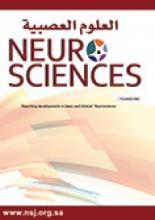Research ArticleOriginal Aticle
Open Access
Epilepsy monitoring units in Saudi Arabia:
Where do we stand compared to developed countries?
Bandar N. Aljafen, Saud M. Alfayez, Mohammed H. Alanazy, Naael Alazwary, Sama M. Alohali and Taim Muayqil
Neurosciences Journal July 2018, 23 (3) 244-249; DOI: https://doi.org/10.17712/nsj.2018.3.20170412
Bandar N. Aljafen
From the College of Medicine (Aljafen, Alfayez, Alanazy, Alohali, Muayqil) King Saud University, and from the Security Forces Hospital (Alazwary), Riyadh, Kingdom of Saudi Arabia
MDSaud M. Alfayez
From the College of Medicine (Aljafen, Alfayez, Alanazy, Alohali, Muayqil) King Saud University, and from the Security Forces Hospital (Alazwary), Riyadh, Kingdom of Saudi Arabia
MBBSMohammed H. Alanazy
From the College of Medicine (Aljafen, Alfayez, Alanazy, Alohali, Muayqil) King Saud University, and from the Security Forces Hospital (Alazwary), Riyadh, Kingdom of Saudi Arabia
MDNaael Alazwary
From the College of Medicine (Aljafen, Alfayez, Alanazy, Alohali, Muayqil) King Saud University, and from the Security Forces Hospital (Alazwary), Riyadh, Kingdom of Saudi Arabia
MDSama M. Alohali
From the College of Medicine (Aljafen, Alfayez, Alanazy, Alohali, Muayqil) King Saud University, and from the Security Forces Hospital (Alazwary), Riyadh, Kingdom of Saudi Arabia
MBBSTaim Muayqil
From the College of Medicine (Aljafen, Alfayez, Alanazy, Alohali, Muayqil) King Saud University, and from the Security Forces Hospital (Alazwary), Riyadh, Kingdom of Saudi Arabia
MBBS
References
- ↵
- Al Rajeh S,
- Awada A,
- Bademosi O,
- Ogunniyi A
- ↵
- Gao L,
- Xia L,
- Pan SQ,
- Xiong T,
- Li SC
- ↵
- Gulpek D,
- Bolat E,
- Mete L,
- Arici S,
- Celebisoy M
- ↵
- Riechmann J,
- Strzelczyk A,
- Reese JP,
- Boor R,
- Stephani U,
- Langner C,
- et al.
- Bolin K,
- Berggren F,
- Landtblom AM
- ↵
- Begley CE,
- Durgin TL
- ↵
- Bennett L,
- Bergin M,
- Gooney M,
- Doherty CP,
- Synnott C,
- Wells JS
- Iyer A,
- Appleton R
- ↵
- Reuber M,
- Torane P,
- Mack C
- ↵
- Buelow JM,
- Privitera M,
- Levisohn P,
- Barkley GL
- ↵
- Alving J,
- Beniczky S
- ↵
- Wagner JL,
- Berg AT
- ↵
- Rubboli G,
- Beniczky S,
- Claus S,
- Canevini MP,
- Kahane P,
- Stefan H,
- et al.
- ↵
- Spritzer SD,
- Pirotte BD,
- Agostini SD,
- Aniles E,
- Hentz JG,
- Noe KH,
- et al.
- Sauro KM,
- Macrodimitris S,
- Krassman C,
- Wiebe S,
- Pillay N,
- Federico P,
- et al.
- ↵
- Labiner DM,
- Bagic AI,
- Herman ST,
- Fountain NB,
- Walczak TS,
- Gumnit RJ,
- et al.
- ↵
- Central Department of Statistics & Information Statistical Yearbook 47
- ↵
- Carosella CM,
- Greiner HM,
- Byars AW,
- Arthur TM,
- Leach JL,
- Turner M,
- et al.
- Panebianco M,
- Zavanone C,
- Dupont S,
- Restivo DA,
- Pavone A
- ↵
- Ansari S,
- Chaudhri K,
- Al Moutaery KA
- ↵
- Al-Said Y,
- Baeesa S,
- Khalid M,
- Abdeen M,
- Kayyali HR
- Revesz D,
- Rydenhag B,
- Ben-Menachem E
- ↵
- Cukiert A
- ↵
- Alfayez SM,
- Aljafen BN
In this issue
Epilepsy monitoring units in Saudi Arabia:
Bandar N. Aljafen, Saud M. Alfayez, Mohammed H. Alanazy, Naael Alazwary, Sama M. Alohali, Taim Muayqil
Neurosciences Journal Jul 2018, 23 (3) 244-249; DOI: 10.17712/nsj.2018.3.20170412
Jump to section
Related Articles
- No related articles found.
Cited By...
- No citing articles found.





